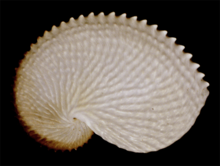Argonauta nodosa
| Knobby argonaut | |
|---|---|
 |
|
| Eggcase of Argonauta nodosa | |
| Scientific classification | |
| Kingdom: | Animalia |
| Phylum: | Mollusca |
| Class: | Cephalopoda |
| Order: | Octopoda |
| Family: | Argonautidae |
| Genus: | Argonauta |
| Species: | A. nodosa |
| Binomial name | |
|
Argonauta nodosa Lightfoot, 1786 |
|
| Synonyms | |
Argonauta nodosa, also known as the knobby or knobbed argonaut, is a species of pelagic octopus. The female of the species, like all argonauts, creates a paper-thin eggcase that coils around the octopus much like the way a nautilus lives in its shell (hence the name paper nautilus). The shell is usually approximately 150 mm in length, although it can exceed 250 mm in exceptional specimens; the world record size is 292.0 mm.A. nodosa produces a very characteristic shell, which is covered in many small nodules on the ridges across the shell, hence the specific epithet nodosa and common name. These nodules are less obvious or even absent in juvenile females, especially those under 5 cm in length. All other argonaut species have smooth ridges across the shell walls.
A. nodosa has a relatively wide distribution covering the Indo-Pacific region as well as the eastern coast of South America. The species is most common in southern Australia, New Zealand, and South Africa. It is only known from the Southern Hemisphere.
A. nodosa is thought to feed primarily on pelagic molluscs. Captive females have been observed readily taking dead prawns and fish. The species is preyed on by numerous predators. It has been reported in the stomach contents of Alepisaurus ferox from the south-western Pacific.A. nodosa has also been found in the stomach contents of Australian fur seals, Arctocephalus pusillus doriferus, in the Bass Strait and southern Tasmania.
...
Wikipedia
